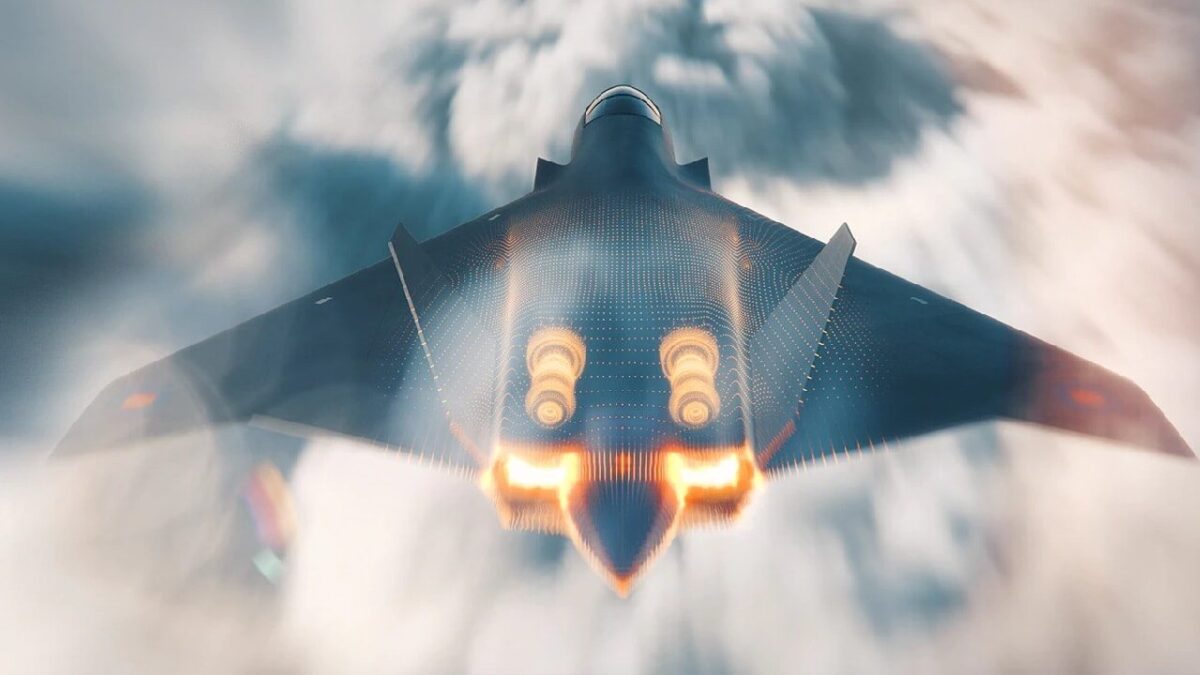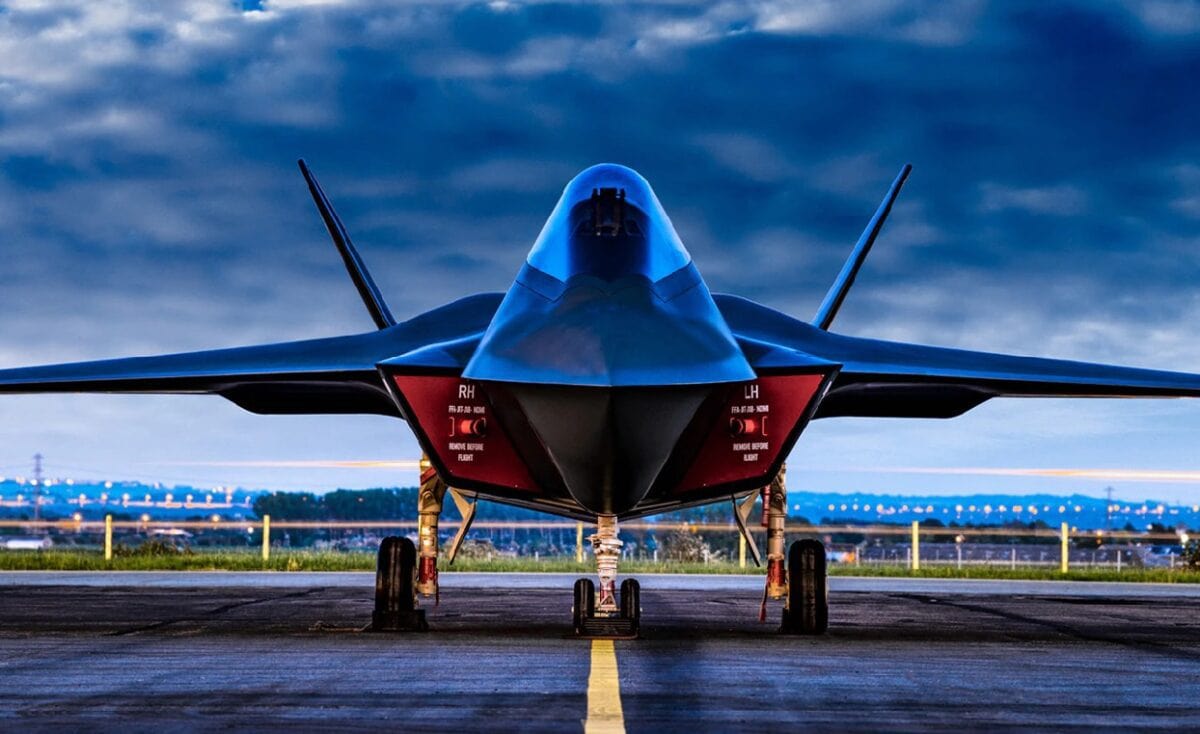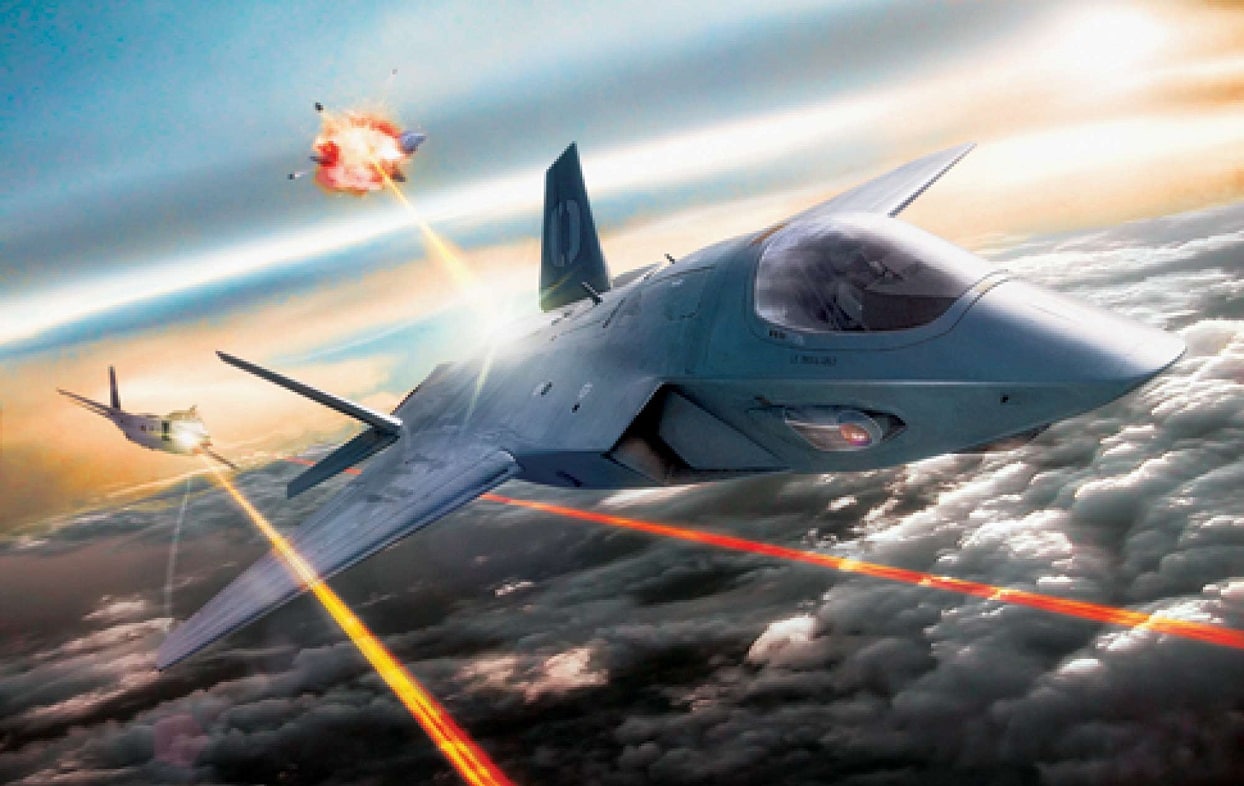At the United Kingdom’s biennial Farnborough air show, British Defense Minister Ben Wallace presented a substantially revised mockup of the conceptual Tempest stealth fighter, a concept that first debuted there in 2018.
The new tailless mockup is still not the final design, but it has already received extensive simulator testing. This design, reminiscent of Northrop’s YF-23 Black Widow prototype, is supposed to lead to the first manned flight of the Flight Test Aircraft demonstrator by 2027.
“Team Tempest,” the partnership developing the aircraft, puts the Royal Air Force and British companies BAE and Rolls Royce alongside the pan-European missile builder MBDA and Italian defense giant Leonardo.
A Chance to Share Staggering Costs
Prior to the presentation, Reuters reported that the United Kingdom and Japan were on the brink of finalizing an agreement to merge their next-generation stealth fighter programs. That agreement purportedly would extend to a range of potential export clients (European customers for the UK, Asian states for Japan).
But at Farnborough, Wallace merely confirmed that a “joint concept analysis” with Italy and Japan would help these countries to “understand areas of shared interest and to explore potential future combat air partnership options.”
Wallace may be cagily underplaying negotiations underway for a fuller merger. But taken at face value, he suggests a more modest cooperation than the “common jet, that may have small differences in design for each country” claimed by Reuters’ sources. At best, commitment to a shared platform has seemingly been put off until the conclusion of a joint analysis later in 2022.
The defense minister does note, however, that Japanese firm Mitsubishi will partner with Leonardo to develop and build two Jaguar multi-mode stealth radar demonstrators. This project kicked off in February 2022, and is planned to take five years.
Big Tempest news from Farnborough. Some 40 years after the EAP prototype that led to Typhoon, BAE Systems & partners will build & fly a supersonic, piloted 6th generation fighter demonstrator within next 5 years. Aircraft has already been ‘flown’ in simulators. #FIA2022 #avgeek pic.twitter.com/ZOSURAWknd
— Tim Robinson (@RAeSTimR) July 18, 2022
In theory, a British-Japanese consortium could spread out staggering R&D costs between the two countries and increase the odds of the project’s satisfactory completion. The United Kingdom faces an especially hard time financing such a costly program.

Tempest Artist Rendition. Image Credit: Industry Handout.
But if that is to happen, Tokyo and London must hash out difficult decisions on what components of the resulting stealth fighter they will use in common, and which they will reserve for their domestic defense-industry champions.
Similar List of Needs for a Stealth Fighter
A possible Japan-UK partnership has been floated since each officially kicked off its sixth-generation fighter program in the late 2010s. Both countries are operators and parts manufacturers for the U.S.’s fifth-generation, single-engine F-35 multi-role stealth jet, designed with greater emphasis on ground-attack performance. For the sixth-generation successor, they want a complementary twin-engine air-superiority fighter that can both rapidly intercept enemy bombers and outperform opposing fighters – even in within-visual-range air-to-air combat, where stealth alone is no certain defense.
The Japanese F-X program, also sometimes called F-3, would replace Japan’s fleet of Mitsubishi F-2 fighters (heavily modified, indigenously built F-16s), while the Tempest could begin replacing the UK’s Eurofighter Typhoon jets in 2035.
Both the UK and Japan seek the typical laundry list of features attached to conceptual sixth-generation jet fighters:
- Larger internal fuel stores so that aircraft can be based more distantly from enemy short-range land-attack missiles;
- AI-enhanced user interface, which among other things could allow the jet to remote-control drone swarms or a smaller number of more capable loyal-wingman drones;
- possibly optional-manning capability – in other words, it could be operated unmanned if so desired;
- greatly enhanced electrical generation to enable use of more powerful jammers and directed-energy weapons (lasers or microwaves!) in both defensive and offensive roles;
- improved networked sensor fusion with friendly forces;
- a high degree of radar-stealth so that operations in zones interdicted by enemy air defenses remains possible, as has proven necessary in Ukraine;
- new industrial technologies (exoskeletons, 3d goggles, automated logistics) to speed up production and lower maintenance burdens.
The Quest for Domestic Stealth Aircraft
Tokyo considered acquiring a hybrid of the F-35, as well as the more air-to-air focused F-22 Raptor, before resolving in 2019 to pursue the indigenous F-3 design at an eye-watering cost of $40 billion to $48 billion. Japan can probably shoulder the bill, given its sharply increasing defense expenditures over the last few years. Mitsubishi earlier built a flying X-2 Shinshin stealth demonstrator to gain experience developing stealth aircraft.

Artist Rendering of Tempest Fighter.
The United Kingdom, meanwhile, developed the stealthy Taranis combat drone prototype, and it contributed 10% of systems to the F-35’s development. However, the big question mark hovering over the Tempest was its likely £24 billion price tag (currently equivalent to $28.7 billion), which seemed beyond the means of Britain’s defense budget. Nonetheless, London has repeatedly affirmed its commitment to test its ability to manufacture fast jets independently of the U.S.
The Challenges of Joint Development
A joint UK-Japan program could reduce each nation’s individual development costs while providing mutual access to the other’s best technologies. However, multinational fighter programs have historically faced serious challenges. Many of these projects fail, or at least lose major partners as they move along.
For starters, partner countries often discover they have significantly different operational requirements and strategic contexts. Sometimes these differences can be reconciled by packing each airframe with features, but that raises complexity and weight to the aircraft, and it also increases development time, costs, and the risks of program failure.
Partner nations also often clash over workshare – and thus profits – for manufacturing different parts of the airframe. They hope to secure lucrative contracts and promote domestic arms industry champions, whose aerospace branches need sustained orders to stay financially viable and technologically ahead.
There are also secondary actors whose slices of the megaproject pie must be accounted for. The Tempest is already being built with cooperation from Italian firm Leonardo and Swedish company Saab, while Japan’s F-X program involves consultation with U.S. defense giant Lockheed-Martin – an arrangement some believe may be sidelined if a deal is sealed with the UK.
Finally, there are risks that shifting political and economic circumstances in either country could jeopardize the sustained financing for a program that will span several decades.
These problems have hampered development of the Franco-German-Spanish FCAS sixth-generation jet. Paris wants a versatile Future Combat Air System that can operate from rough airbases in developing countries, deliver nuclear weapons, and remotely control armed drones. Berlin, however, finds nukes and combat drones politically icky, is more concerned with home air defense than global operations, and expects technology transfers the French are none too keen on. Furthermore, when a new German government opted to purchase F-35 jets from the U.S., the French saw that as a sign Berlin would divert money from the FCAS, slowing down its development.
Prospect for the UK-Japan Cooperation
At a minimum, Japan, the UK, and the Tempest’s continental partners, Leonardo and MBDA, are already exchanging component technologies for high-thrust engines and advanced radars, as well as missile technology for their sixth-generation fighters. Some of the finalized components could remain mostly identical across their various planned aircraft.
At most, the UK and Japan might still co-develop a common aircraft with only “small differences” in components —though the temptation to insist on many “small differences” may prove hard to resist.
The dilemma is that Tokyo and London must sacrifice some domestic industrial and political interests if they want to save on R&D costs. On the other hand, every country-specific component creates more profit for domestic industry, but comes at a heavier taxpayer burden.
Fortunately, the Tempest deal is predated by British and Japanese cooperation on several component technologies. These include the Jaguar radar mentioned earlier, as well as the Joint Air-to-Air Missile that pairs the advanced throttleable engine technologies of the MBDA Meteor air-to-air missile with a Japanese AESA radar seeker.
Despite cooperation on the engine testbed, however, Rolls Royce and Japanese firm IHI have already spent years developing their own high-tech engines. They seem less likely to agree to a fully common design. Developing a common airframe for two different engines could prove tricky: The configuration of air intakes is critical to minimizing a stealth fighter’s radar cross-section.
If the UK and Japan can compromise without too much bloat, jointly developing a stealth fighter might save billions of taxpayer pounds and yen, while also reducing unit costs thanks to economies of scale. Such Japanese-British cooperation would also reinforce London’s tilt toward a greater presence in the Pacific.
However, Wallace’s cautious comments in Farnborough about the extent of UK-Japan collaboration hint at possible obstacles for any cooperation that goes deeper than current, component-level technology-sharing.
Sébastien Roblin writes on the technical, historical and political aspects of international security and conflict for publications including the The National Interest, NBC News, Forbes.com, War is Boring, Inside Unmanned Systems and 19FortyFive, where he is Defense-in-Depth editor. He holds a Master’s degree from Georgetown University and served with the Peace Corps in China. You can follow his articles on Twitter.

